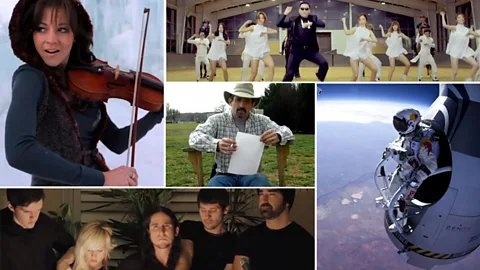YouTube: The cult of web video


YouTube's greatest hits of 2012 are a bizarre mix with seemingly little in common. So, is it possible to identify the secret ingredient of a viral hit?
A horse-ride-miming Korean rap, a man in a pressurised suit falling approximately 40,000 metres, a father repeatedly shooting his daughter’s laptop at point-blank range, and a documentary about child soldiers and war crimes in Uganda. According to YouTube viewers, these were among the top trends of 2012 - one of which, Gangnam Style, has just passed one billion views. There was a presidential election too, although some netizens may only have noticed it thanks to the rap battle restaging.
With 72 hours of video uploaded to YouTube every minute, almost every moment of modern history is a cult waiting to happen. And it is becoming big business. “There are companies who spend millions and millions of dollars trying to… create these videos,” YouTube trends manager Kevin Allocca told the Wall Street Journal.
The billion dollar question is how: how to make your video “go viral”, spreading your particular slice of contemporary culture across the planet like a contagion.
Amid 2012’s bewildering eclecticism, perhaps the most revealing place to begin is not by looking at what successful videos are doing, but what they aren’t – a process that punctures several conventional wisdoms. Brevity, for example, isn’t essential: four of the global top ten last five minutes or longer, and one lasts half an hour. Comprehensibility can’t be essential either, unless the best part of a billion people have learned to speak Korean during in the last 12 months; and nor can music or dancing, with the top ten divided evenly between speech and song.
Similarly, although sex may remain the most powerful form of advertising, it barely features within this list. Visual excitement won’t do either, given that the year’s second-biggest hit features a single camera pointed at five people and a guitar. Silliness is more important – but not vital, given that both the Kony documentary and the jump from space are entirely serious.
You could argue that professional production is a strong contender for sine qua non. Talking to AFP, Allocca noted that "almost everything on the list this year was created by professional or creative talent for an online audience... It's different from years ago, when homemade videos or random, funny stuff from smartphone cameras were the hits." But even this is not quite enough to explain what makes a hit, thanks to one father’s strictly amateur assault on a laptop.
Hodgepodge of hits
If almost every attempt to build common ground melts away under scrutiny, that’s because – no matter how much you might wish you could bottle and sell it – virality isn’t actually a property of these videos at all. It’s a property of their audience: a description not of a particular object, but of the ways in which that object is used.
Consider that immortal phrase of our age: “I have to show you something”. It marks the precise moment when the contents of your screen became grist to the mill of sharing, tribute, parody, discussion, action and social display. To pass on a video or link is to become an evangelist for an instant cult: to gain the status of an initiate, complete with social capital and mutual LOLs. Unlike a biological virus, which hijacks hapless cells no matter what their owners might want, these are infections you must decide to pass on.
Cult objects and trends have, of course, been venerated in both high and low culture since long before the internet. In a classic essay written in 1984, Italian author and academic Umberto Eco nominated the 1942 film Casablanca as a case in point: something that is “not a work of art” but rather “a hodgepodge of sensational scenes strung together implausibly”, fit for gleeful dismantling and personalised appropriation.
“In order to transform a work into a cult object one must be able to break, dislocate, unhinge it so that one can remember only parts of it,” Eco observed. Casablanca offers a compendium of genre cruxes, assembled by multiple directors and writers who didn’t even know how it would end when they began filming. YouTube is the next phase of this evolution: a pre-dismantled hodgepodge whose greatest hits, like classic movie lines, take on countless afterlives.
Most online video offerings aspire neither to art nor originality, but to likes, shares, tributes, clicks, eyeballs and interactions. It’s a way of giving the world back to itself to play with – and the most crucial story of all is not what happens onscreen, but what happens if clip meets world and world falls in love with clip.
There’s also a safety in numbers that suspends every other kind of nagging question. If a million people can’t be wrong, then a billion can render right and wrong irrelevant: this much sharing lends whatever you may be watching (and whatever you may feel moved to create in response) a perfect legitimacy.
At its best, it’s a joyful process, and joyfully ephemeral. For five minutes, we are embraced by the warmth of cult experience – the moment shared, the code of access and veneration – without the sinister inconvenience of self-mortification or ranting religion. The viewing preferences of one year may not amount to a hill of beans. But we’ll always have Gangnam Style.
Do you agree with Tom? What makes a viral video? To comment on this article or anything else you have seen on Future, head over to our Facebook page or message us on Twitter.
